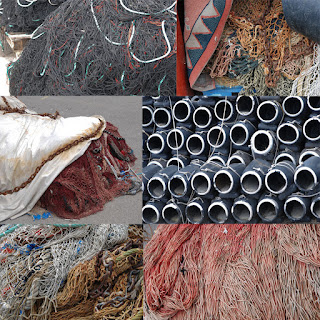After three months of being extremely busy with coordinating dolls quilt exhibition, preparing my Procion Master classes and lecture on the history of textile for the "Tradition" festival, I am back to my art material essay. I have so much to say, that I am scared to bore the teachers, moreover, I don't rely on any expert opinions or special books for that matter. Will my conclusions be commonplace or far fetched? Shall I go to the libraries to seek help or take the risk and leave it as it is. In the meantime, while considering these two approaches, I am trying to start using Photoshop to make collages based on my picture collections. Very convenient to use a collage instead of putting dozens of photographs one after another on the website or blog.
I love rusty objects, state of decay and disrepair,except in my own house. But this is probably my karma: love ruins-live in ruins))
Bon courage pour la peche (lucky fishing!) is written on the rusty surface, the first photograph


Ropes ans nets weathered and torn but still very picturesque


I was also curious how the sailors ropes could inspire artists and architects. The interior of one of the sake bars in Melbourn is decorated with manila ropes (http://www.booooooom.com)

"The bridge" by Simon Starling (http://www.domusweb.it)

And last, but not least The patterned
Concrete Wall by Dany Marti
(http://www.apartmenttherapy.com/inspiring-rope-patterned-cemen-121420)

more of this
artistWhat a long way one should go from a pile of neglected fishermen nets on the shore to the beautifully patterned wall structures. Chapeau!



























